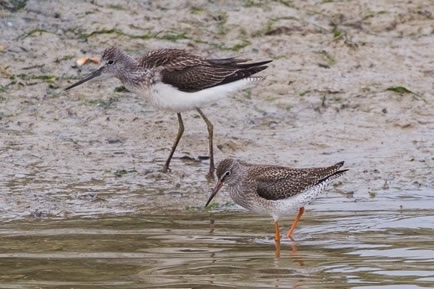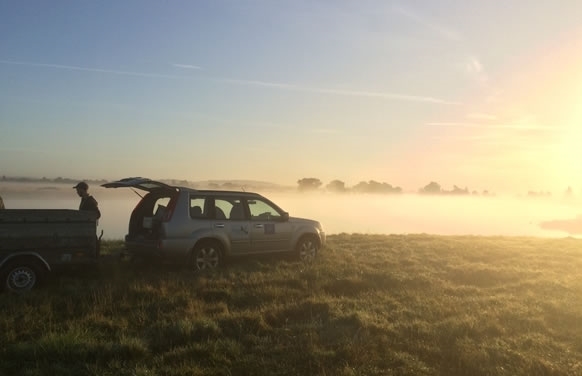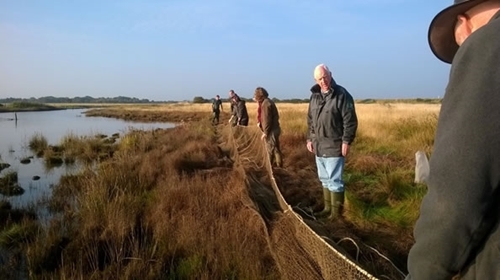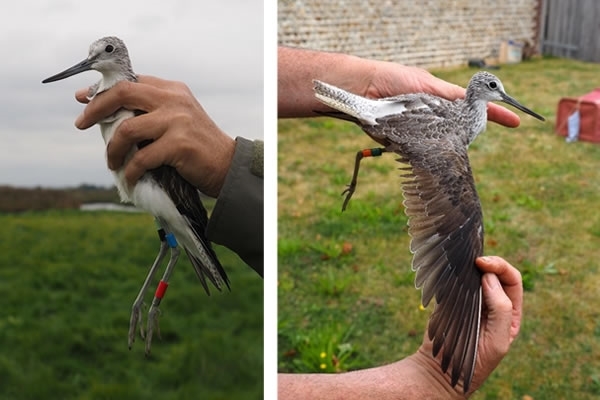By Lizzie Grayshon, Waders for Real Project Ecologist and Ryan Burrell, Biometrics/GIS Assistant
This summer/autumn myself and several other keen ringers from the GWCT have been assisting with the ‘Greenshank Migration Story’ project based in the Solent and mainly at Chichester Harbour (50km east of our Waders for Real study area). This is a voluntary project run by the Farlington Ringing Group and partly funded by the Heritage Lottery Fund, Sussex Ornithological Society, British Birds, Hampshire Ornithological Society, Migrate Technology and Chichester Harbour Conservancy.
Greenshank are a long-legged wading bird, similar in size to lapwing, with green legs and a slightly up-turned bill. These features help distinguish it from other waders which it may been seen with such as redshank.
 Greenshank (top) with Redshank (bottom) (Image courtesy of Ron Knight)
Greenshank (top) with Redshank (bottom) (Image courtesy of Ron Knight)
Where are they from? Where are they going?
At this time of year, the greenshanks we see in southern Britain are on passage to their winter sites in south-western Europe and West Africa, with a small number staying to winter in the UK. During their autumn migration, they stop at several key locations along the North Sea and English Channel, for refuelling and moulting, with one stop-over location being Chichester Harbour.
Although, we have a population of birds which breed in Scotland, the birds which use Chichester Harbour are thought to be part of the population that breed in Scandinavia and Western Russia. The ‘Greenshank Migration Story’ project began in 1992, colour ringing birds at Farlington and expanded to Thorney and Chichester in 2000, with the aim of better understanding the migratory strategies of greenshank, both at a local level and throughout their lifecycle and to engage communities around these nationally important sites.
To answer questions like this, we need to identify individuals in the field so as with our Avon Valley lapwing, each individual bird caught under the project is given a different combination of colour rings. So far they have received over 2000 sightings with bird’s colour-ringed in the Solent being sighted in France, Spain, Morocco, Corsica, Italy, Germany, The Netherlands, Norway and one recovered in the White Sea, W Russia. There has also been one sighting of one breeding in Scotland, this shows us that our wintering population comes from Scotland to Western Russia and possibly even further east, we just don't know full extent yet!
For more information on the project please visit the website. If you see any colour-ringed birds, please report the sighting here or email greenshankproject@googlemail.com.
How we catch them and what is cannon-netting?
As some of you will know waders in general are easily spooked birds, quick to get on the wing at any sign of danger. This means that our capture method needs to be hidden from the birds view, until they are in a position to be safely caught.
To do this we use cannon-nets to catch the birds’, though it sounds dangerous it is a commonly used method of catching wading birds for research and the welfare of our study species is the highest priority throughout. The method involves having an experienced team of bird ringers including a cannon-net licensee (licenced by the British Trust for Ornithology) and a lot of specialised kit.
The net is set several hours before high tide, long before any birds are present, along the edge of a tidal lagoon where the birds roost during high tide.
 Early morning setting the cannon-net at Thorney Island.
Early morning setting the cannon-net at Thorney Island.
Once the net is in place the cannons are positioned and then dug into the ground, metal projectiles are attached to the net and inserted into the cannons. The cannons are then wired up to a firing box which is positioned away from the net where the team wait out of sight from the timid greenshank.
 The team setting the cannon-net along the edge of the estuary (Image courtesy of Andrew Carter)
The team setting the cannon-net along the edge of the estuary (Image courtesy of Andrew Carter)
Now we wait until the birds are in position and it is safe to fire. When the cannons are fired, the projectiles are propelled high over the top of the birds, lifting the attached net safely over the flock before they have chance to fly off. If successful, everyone runs to the net to remove the birds as quickly as possible.
During this time, all birds are covered with a light material sheet, which calms the birds and ensures that we inflict the minimum amount of stress. After removal, the birds are placed in darkened keeping cages where they can move around freely until the team are ready to start processing.
Processing the birds involves fitting each bird with a uniquely-numbered BTO metal ring and a set of colour-rings to allow for identification in the field. Several biometrics are also taken: wing length, head and bill length, bill length and weight (there have been amazing recent findings for red knot from basic measurement data like this).
The birds are also aged as either juvenile (hatched this year) or adult (hatched in the previous year or any year before this) which allows us to get an idea of the age structure in the population and investigate differences in adult and juvenile movements.
Another purpose of this autumn's catches was to retrieve geolocators, fitted around 18 months ago. We have managed to recover two so far this autumn and we will be trying again this month to retrieve more tags.
As a side note, the oldest greenshank recovered as part of the BTO ringing scheme is 16 years and in The Netherlands, a greenshank was recovered 24 years after it was ringed. Amazing!
 Left, greenshank with individual colour-ring combination. Right, adult greenshank distinguished by active wing moult with two generations of feathers (browner old feathers and darker grey/black newer ones)(Image courtesy of Andrew Carter)
Left, greenshank with individual colour-ring combination. Right, adult greenshank distinguished by active wing moult with two generations of feathers (browner old feathers and darker grey/black newer ones)(Image courtesy of Andrew Carter)
After processing the birds are released, with the hope that they will soon be spotted by either a team member or keen birdwatcher. It is great to be involved in another local wader conservation project, especially one which is run solely by volunteers and highlights the dedication people have to this beautiful bird. I see many parallels with my devoted stakeholders and Lapwing in the Avon Valley.
The project is run by Pete Potts, who runs the cannon-net catches, Anne de Potier, who spends many hours conducting recce’s before catches and colour ring re-sighting and Ruth Croger, who makes all the colour rings. Thanks also to Simon Sprackling the tenant farmer for access to the sites and to the Station Staff Officer of Baker Barracks, Thorney Island.
With thanks to Pete and Anne for their input and advice.
Please support Lizzie's vital work with waders